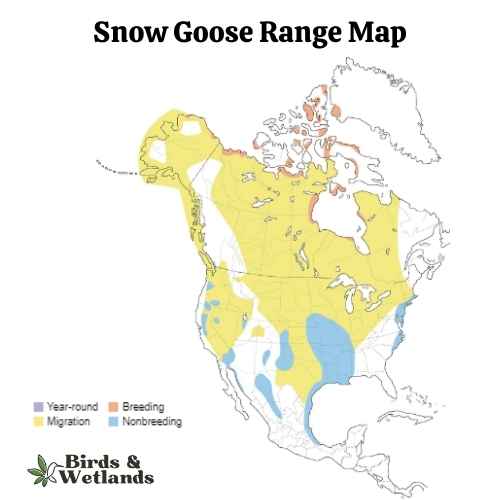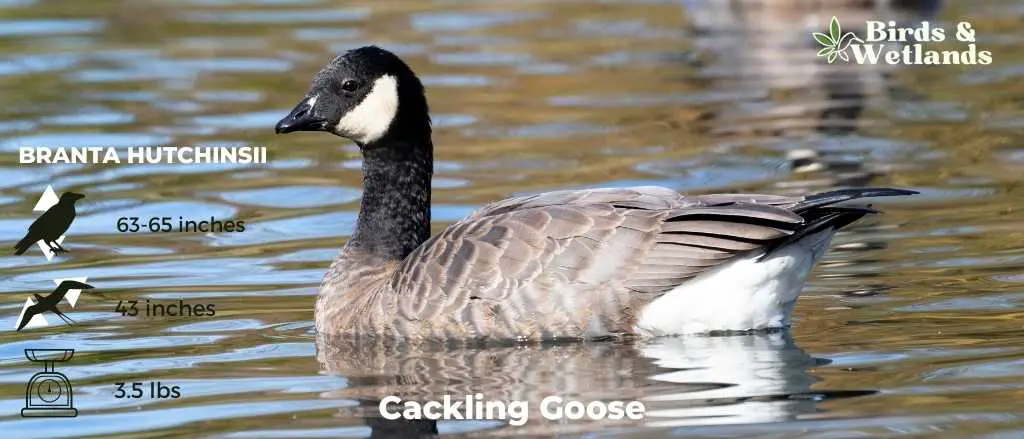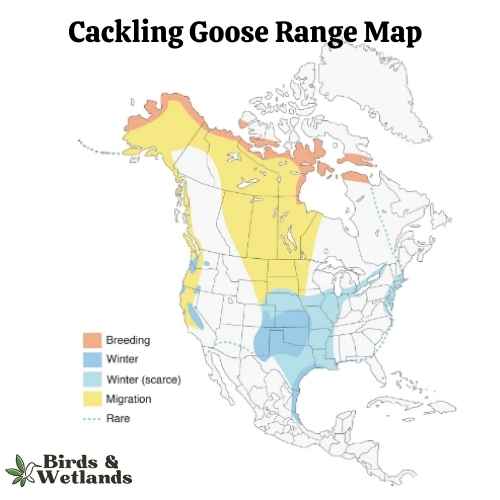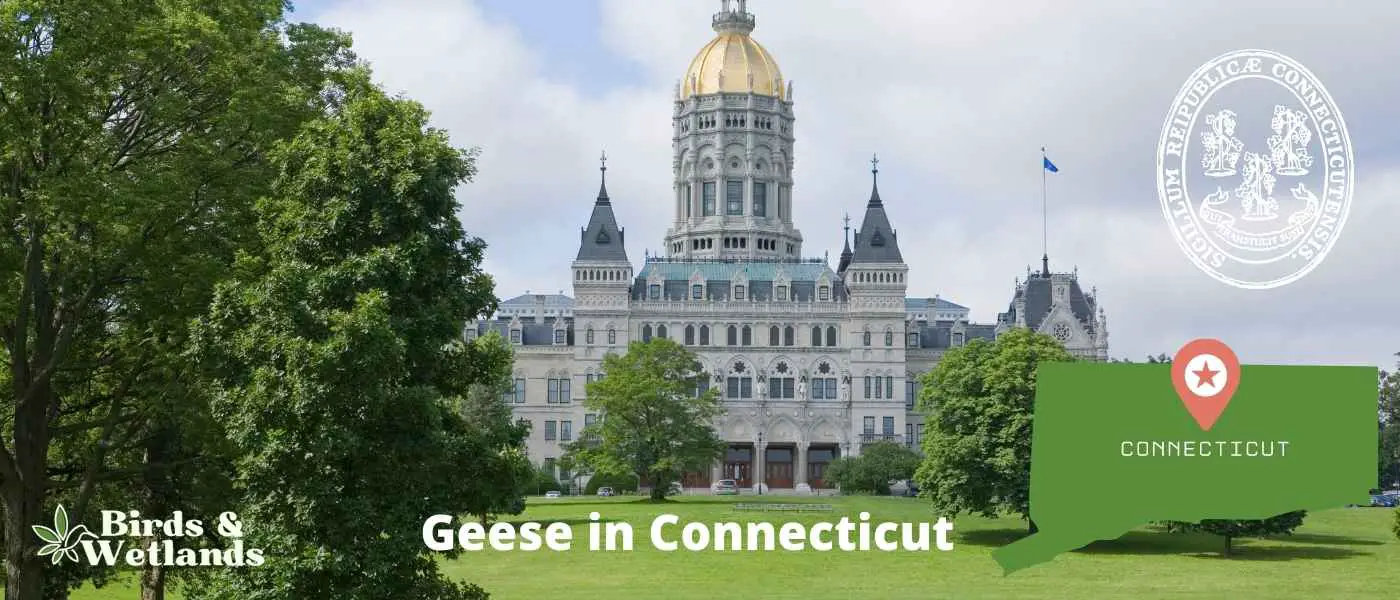If you’re a bird watcher, you’ll love Connecticut during the winter.
You can see all sorts of geese at various parks and ponds throughout the state.
There are several places where you can get up close and personal with these beautiful creatures, including Mill Woods Pond in Wethersfield, New Haven’s Edgewood Park, Watertown, and Durham.
What Geese Are in Connecticut?
Connecticut is the home of 3 goose species and 2 swan species.
- Canada Goose
- Snow Goose
- Cackling Goose

Canada Goose


Canada Goose Sound
Scientific Name: Branta canadensis
Length: 30 to 43 in
Wingspan: 50–73 in
Weight: 5.7–14.3 lb
The Canada Goose is a large, well-known species of waterfowl noted for its distinctive appearance, familiar “honk,” and migratory behavior.
Appearance: Both male and female Canada Geese have a similar appearance, featuring a black head and neck with distinctive white patches on the cheeks and chin. The body is primarily brown with a lighter, often white, underbelly.
Diet: Canada Geese primarily feed on plant matter, including grasses, aquatic vegetation, and grains. They can often be seen grazing in parks, lawns, and fields, as well as dabbling in water bodies.
Reproduction: Canada Geese typically nest on the ground near water bodies, often on islands or other isolated areas to avoid predators. The female lays a clutch of about 4 to 6 eggs, which she incubates alone for around a month.
Snow Goose


Snow Goose Sound
Scientific Name: Anser caerulescens
Length: 25 to 31 in
Wingspan: 53 to 65 in
Weight: 4.5 to 6.0
The Snow Goose is a large species of waterfowl known for its vibrant white plumage and significant migratory flights.
Appearance: True to their name, Snow Geese are predominantly white with black wingtips. They also have a pink bill, pink legs and feet. A color morph, known as the “Blue Goose,” displays a bluish-gray body with a white head, but is considered the same species.
Diet: Snow Geese primarily feed on plant matter, such as grasses, sedges, and small grains. They can often be seen in large flocks foraging in fields and marshes, and during migration and winter, they can cause considerable damage to agricultural fields due to their feeding habits.
Reproduction: Snow Geese typically nest on the tundra, near water bodies. The female builds the nest and lays a clutch of about 3 to 5 eggs, which she incubates alone for approximately three weeks. Once hatched, the goslings can feed themselves but stay with their parents for protection until they can fly.
Cackling Goose


Listen
Scientific Name: Branta hutchinsii
Length: 24.8–25.6 in
Wingspan: 43-45.7 in
Weight:3.5 lbs
Cackling Geese are particularly known for their high-pitched, cackling calls, which is the source of their name. Despite their small size, these geese are renowned long-distance migrants, with some populations traveling thousands of miles between breeding and wintering grounds.
Appearance: With a similar color pattern to the larger Canada Goose, the Cackling Goose features a black head and neck, white chinstrap, light tan to cream chest, and brownish-grey body. One defining characteristic is its noticeably smaller size and stubbier neck compared to its larger counterparts.
Diet: Like many geese, the Cackling Goose’s diet mainly consists of plant matter. This includes grasses, seeds, and aquatic vegetation. They are often seen grazing on land or dabbling in shallow water.
Reproduction: Cackling Geese usually nest on the ground in elevated areas near water bodies, such as riverbanks or lakeshores. The female lays a clutch of 2 to 8 eggs and is responsible for incubation, while the male stands guard nearby. Incubation lasts for about a month.
Hunting Geese in Connecticut
Yes, it is legal to hunt geese in Connecticut. The hunting season for this species typically runs from October through January.
To hunt geese in Connecticut, you must have a valid hunting license, and you must follow all laws and regulations regarding allowable firearms and ammunition.
When hunting on private property, you must have the permission of the landowner.
Can You Shoot a Goose in Connecticut?
In Connecticut, you need a license to shoot a goose. You can get a license from the Department of Energy and Environmental Protection (DEEP). The daily bag and possession limits are as follows:
Canada Goose – Daily Bag: 25, Possession Limit: No Limit
Brant – Daily Bag: 2, Possession Limit: 6
You can check Connecticut’s daily bag and possession limits here.
Where Can I Hunt Geese in Connecticut?
If you’re looking for a place to hunt geese in Connecticut, there are several state-owned waterfowl hunting areas that are open to the public. These areas are typically well-stocked with geese, and they offer a variety of amenities to make your hunt more enjoyable.
Is There a Goose Hunting Season in Connecticut?
In Connecticut, the goose hunting season typically runs from October to March. This varies slightly from year to year, so it’s always best to check the current regulations before planning your hunt.
Take Away on Geese in Connecticut
Conclusion paragraph: Connecticut offers some of the best goose hunting in the country. With three different species of geese and a long season, there is something for everyone looking to bag a bird.
Before you head out into the field, make sure you are familiar with the regulations and get your license today.


